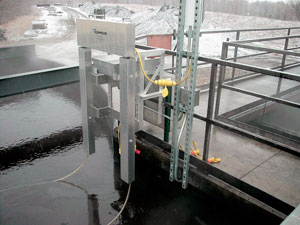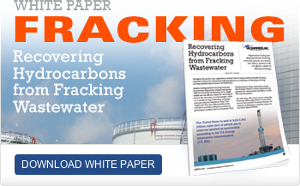Plant Gains Efficiency by Replacing Vacuum-Truck Process

A steel mini-mill located in Portage, IN, that produces and sells hot-rolled steel in the north central United States and Canada. The plant produces about 700,000 tons a year and employs about 400 people. On site is an electric arc furnace melt shop that produces continuous-cast steel slabs and a hot-strip rolling mill for further processing of slabs into rolled coils.
The mini-mill’s raw materials are scrap metal and chemical additives. The scrap metal is melted and recast into slabs, which ultimately become coils of flat steel that customers purchase to make a variety of durable products. The heat-intensive process uses water to cool in-process materials to specified temperatures. After this, the water is sent to four above-ground concrete cooling towers to release the heat it has absorbed. But during hot strip mill production, tramp oil mixes with the water, and this mixture collects in two basins and a scale pit. Before the water can be cooled and reused, the oil must be removed to keep the cooling towers and other plant equipment running smoothly, and to prevent contamination of the product.
PROBLEM: The plant had employed a company to periodically vacuum the oil out of the water as it sat in the pit and two collection basins — one with a 490,000-gallon capacity and the other one with a 285,000-gallon capacity. But this method did not adequately separate the oil and water, and it didn’t provide an option to operate continuously, as the plant does.
SOLUTION: The steel mini-mill now uses six Oil Skimmer’s oil-recovery systems to remove the tramp oil from the water in the collection basins as well as from a scale pit that was added during a rolling mill upgrade at the hot-strip mill. When operating continuously, each system removes 150 gallons of oil a day, said Ehren Plew, plant mechanical engineer, although they are capable of removing much more if needed. In a unique anti-clogging design, the Oil Skimmer ‘s system has a polyurethane tube that attracts and collects the waste oil/grease as it floats on top of wastewater. The tube passes through a scraper system to remove the oil, which flows by gravity into a containment drum.
BENEFITS: The system operates independently and, if needed, can run 24 hours a day, seven days a week. This was a significant improvement over periodic vacuuming, Plew said. The skimmers run whenever needed and for as long as needed without maintenance.
“They are relatively maintenance-free, and they are certainly trouble-free,” Plew said. “They run 24/7 with no manpower. It would be uneconomical to have a vacuum truck running 24 hours a day.” Additionally, the skimmers are more effective at separation, Plew said. “The vacuum truck sucks out a lot of water, and these remove just the oil. So there is a lot less waste.”
Jim Petrucci, Vice President of Oil Skimmers, said the vacuum method of oil removal has its place in industry, but it’s not the best choice for an on-going need, such as steel min-mills. “Even the most conscientious vacuum operators pick up a lot of water. And even if they do vacuum and get all of the oil, the next day you have more oil in the water. Our system runs continuously. Vacuuming is great when you have a spill, but it doesn’t address continuous build up.” Additionally, vacuum services can cost fro $100 to $300 an hour, which means in most situations an investment in an Oil Skimmer system pays off quickly through cost savings, Petrucci said. The steel mini-mill uses both the Oil Skimmer Model 5H and the Model 6V. Both are made with internal components of high-strength steel and bronze for durability. External parts are made from abrasive-resistant ceramic. The machine has a lifespan of more than 25 years.



